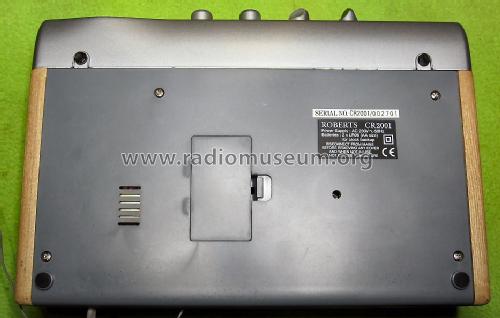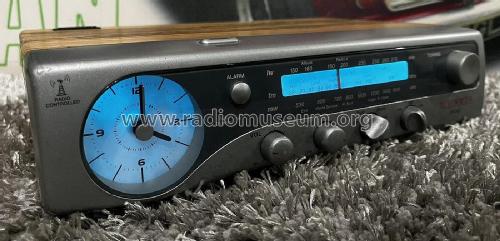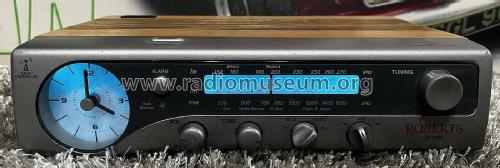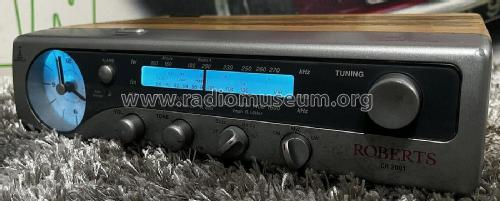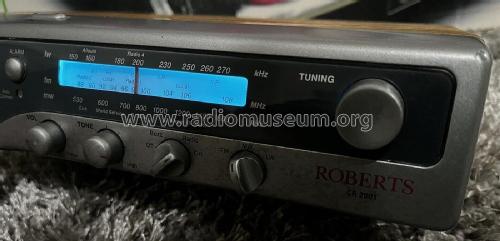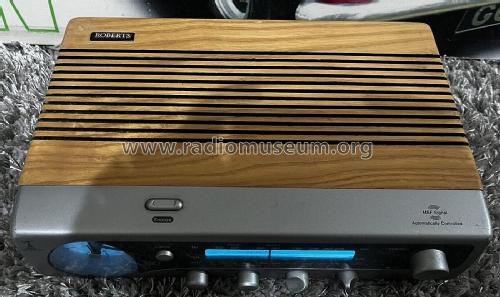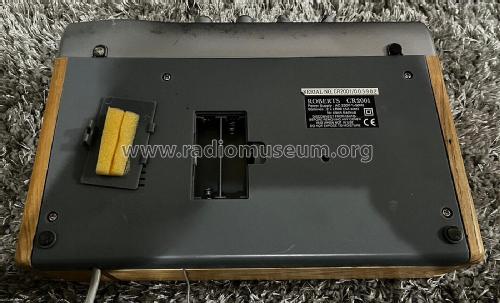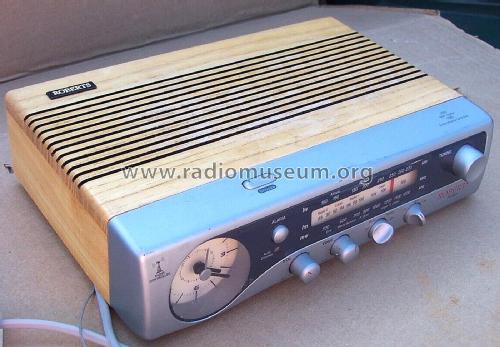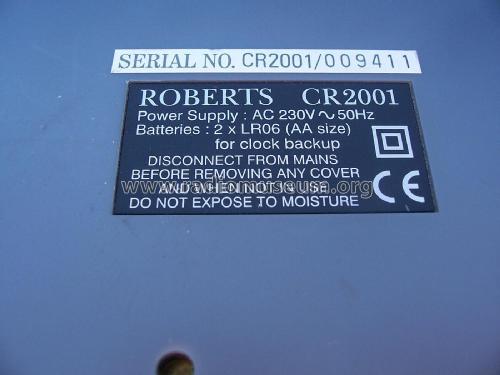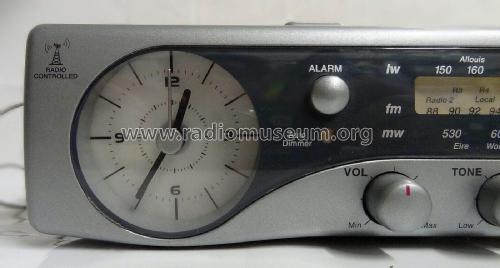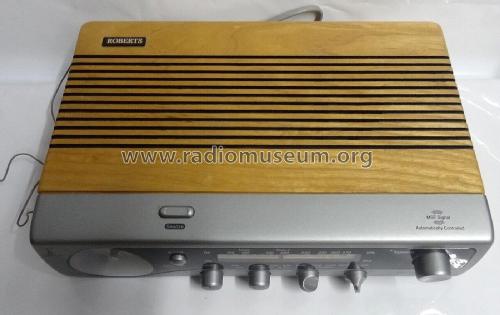Radio Alarm Clock CR2001
Roberts Radio Co.Ltd., East Molesey, Surrey, UK
- Country
- Great Britain (UK)
- Manufacturer / Brand
- Roberts Radio Co.Ltd., East Molesey, Surrey, UK
- Year
- 2001 ??
- Category
- Broadcast Receiver - or past WW2 Tuner
- Radiomuseum.org ID
- 251014
- Number of Transistors
- Semiconductors present.
- Semiconductors
- Main principle
- Superheterodyne (common)
- Wave bands
- Broadcast, Long Wave and FM or UHF.
- Details
- Radio with other functions
- Power type and voltage
- Alternating Current supply (AC) / 220-240 Volt
- Loudspeaker
- Permanent Magnet Dynamic (PDyn) Loudspeaker (moving coil) / Ø 3 inch = 7.6 cm
- Material
- Wooden case
- from Radiomuseum.org
- Model: Radio Alarm Clock CR2001 - Roberts Radio Co.Ltd., East
- Shape
- Tablemodel with Clock ((Alarm-) Clock Radio).
- Dimensions (WHD)
- 263 x 68 x 170 mm / 10.4 x 2.7 x 6.7 inch
- Notes
-
Radio Alarm Clock, the clock has 2 AA batteries for backup, they do not power the radio.
This unit is fitted with a MSF Radio controlled clock which receives a signal on a frequency of 60 kHz. The MSF signal carries a time and date code that can be received and decoded by a wide range of readily available radio-controlled clocks.
The MSF signal is transmitted from Anthorn Radio Station in Cumbria UK. by Babcock (formerly VT Communications), under contract to NPL.
- Author
- Model page created by Mike Edwards † 25.10.21. See "Data change" for further contributors.
- Other Models
-
Here you find 100 models, 96 with images and 44 with schematics for wireless sets etc. In French: TSF for Télégraphie sans fil.
All listed radios etc. from Roberts Radio Co.Ltd., East Molesey, Surrey, UK
Forum contributions about this model: Roberts Radio Co.Ltd: Radio Alarm Clock CR2001
Threads: 2 | Posts: 3
Hello,
on special request find english language version below:
However see for pictures and links german version (thus to avoid duplicating)
leads directly to german language version containing further diagrams and external links...
Dear friends of Radiomuseum,
There is hardly anyone to whom the German DCF77 time signal transmitter is not a well-known term (77.5 kHz, located at Mainflingen near Frankfurt/Main, Germany).
However, even in the north of Germany, the English transmitter MSF60 (60 kHz, Anthorn Cumbria, formerly located at Rugby) can also be received with a reasonable level is probably not so well-known.
(The search for keyword "MSF 60" provides only few answers.)
So I would like to try to close the information gap with the following text a little bit.
In short, the principle of the time signal transmissions, and what - roughly sketched - markes the difference both transmitters from each other.
In the minute n, the time and date code is broadcast for the minute n+1.
For DCF77 (77.5 kHz) the carrier oscillation is reduced to 15% of the maximum level once per second (with the exception of second 59).
Where the start of the second’s blankings is always at a distance of seconds, the recovery of the transmitter amplitude to 100% is delayed by 100 or 200 milliseconds.
In the length of these blanking times the logic states are represented,
100 milliseconds for "zero", 200 milliseconds for "one", which can then be decoded by the radio clocks.
The MSF 60 (on 60 kHz) Scottish time signal transmitter does no more use the "fast code" in second 1, simultaneously to the “slow code”, thus the "fast code" has been totally replaced by the “slow code” since a couple of years ago. That “slow code” looks like the code transmitted by DCF77.
However, a carrier reduction of MSF 60 exists at almost 0%, and there are more blanking durations, in addition to the 100 and 200 milliseconds, namely 300 and 500 milliseconds. The 59th second blanking is also transmitted.
If you listen to this station for the first time, the "double pulses" in the time interval between second 1 and second 15 are particularly noticeable.
This makes the use of a DCF77 decoder for MSF 60 simply impossible, which can only interpret a carrier reduction within one second interval and only two time intervals, and also requires the extended "pause" for the minute synchronization, with the absence of the 59th minute blanking.
The question will be asked why it is so complicated with MSF 60.
Well, in reality, two independent codes, code A and
Code B are transmitted simultaneously.
In Code A, there are only 100 and 200 millisecond blankings,
in those there are hidden the "pure" time and date informations in the BCD code.
For code B, 100 and 200 milliseconds are equal to logic "zero" and 300 milliseconds equal to logic "one".
With code B the DUT1 code - which has no more been transmitted by DCF77 since the late seventies of the last century - is transmitted in seconds 1 to 15, which contains the information about relative deviations of the actual earth rotation speed time to the atomic frequency normal time.
Furthermore, the parity bits and the british summer time bit appear in the B code.
Since a series of fixed bits - always an equal pattern (01111110) - are transmitted on the end (seconds 52 to 59) in the A code and then the 500 millisecond blanking in minute zero to detect the start of the minute, one also could achieve without a parity bit check a reasonable time and date display on radio controlled clock.
This means in practice that one does not necessarily have to decode the B-code, if one waives the representation of DUT1 and parity check.
The diagrams show the blanking times in MSF 60
And the comparison between DCF77 and MSF 60
If the two timecodes of DCF77 and MSF 60 are compared with each other, one also recognizes that the BCD coding is reversed (LSB interchanged with MSB).
Also, the bit assignment of the information from year to minute is interchanged.
Then, at MSF 60, the parity bits are not spread over, but are sent sequentielly all together at the end in bits for seconds 54 to 57.
The sum of the bits from 17 to 24, 25 to 35, 36 to 38 and 39 to 51 in the parity bits 54 to 57 is supplemented to an odd number of ones, ie to "odd parity", contrary to the "even parity" on DCF77.
There is another special feature in the assignment of the Weekdays to sent digits.
Although also in the UK the calendar week starts on Monday with counter number 1,
the Sunday will not be the same as for DCF77 consequently with the number 7
but with the number 0 posted.
Acoustically obvious in MSF 60 is also the missing random number phase modulation, which is seen as "noise" during DCF77 reception, which only disappears completely during the blankings.
Attachments
- MSF60 receiver plot demonstration (185 KB)
Karl-Heinz Bradtmöller, 24.May.17
führt zur englischsprachigen Version...
Liebe Radiomuseumsfreunde,
es gibt wohl kaum jemanden, dem der deutsche Zeitzeichensender DCF77 nicht ein wohlbekannter Begriff sein dürfte ( 77,5 kHz, Mainflingen bei Frankfurt/Main).
Dass aber auch in weiter nördlich gelegenen Bundesländern der englische Sender MSF60
(60 kHz, Anthorn Cumbria, vormals Rugby) mit passablem Pegel zu empfangen ist, ist wohl nicht so bekannt. (Die Suche nach Stichwort „MSF 60“ liefert nur spärlich Antworten.)
Deswegen möchte ich mit dem folgenden Beitrag gerne ein wenig zum Schließen dieser Lücke beitragen.
Kurz das Prinzip der Zeitzeichenaussendungen, und, was grob skizziert beide Sender voneinander unterscheidet.
In der Minute n wird der Zeit- und Datumscode für die Minute n+1 ausgestrahlt.
Bei DCF77 (77,5 kHz) wird die Trägerschwingung auf (neuerdings) 15 % des Maximalpegels einmal pro Sekunde (mit Ausnahme der Sekunde 59) abgesenkt.
Wobei der Beginn der Sekundenabsenkung stets im Sekundenabstand erfolgt, das Wiederansteigen der Senderamplitude auf 100 % aber um 100 bzw. 200 Millisekunden verzögert ist. In der Länge dieser Austastzeiten liegen die logischen Zustände, 100 Millisekunden für „Null“, 200 Millisekunden für „Eins“, was dann die Funkuhren decodieren können.
Der schottische Zeitzeichensender MSF 60 (auf 60 kHz) verwendet seit einiger Zeit nicht mehr den „Fast Code“ in Sekunde 1, sondern auch den „Slow Code“, vergleichbar mit dem DCF77 Code. Allerdings eine Trägerabsenkung auf nahezu 0% und weitere Austastdauern, zusätzlich zu den 100 und 200 Millisekunden, nämlich auch noch 300 und 500 Millisekunden. Ferner wird die 59. Sekunde ebenfalls gesendet.
Hört man diesen Sender das erste Mal, fallen einem vor allem die „Doppelimpulse“ im Zeitintervall zwischen Sekunde 1 und Sekunde 15 stark auf.
Besonders das macht die Verwendung eines DCF77-Decoders für MSF 60 schlichtweg unmöglich, der lediglich eine Trägerabsenkung innerhalb eines Sekundenintervalls und nur zwei Zeitintervalle interpretieren kann, ferner zur Minutensynchronisation die verlängerte „Pause“ unter Wegfall der 59. Minutenaustastung benötigt.
(Im Verlauf dieses Beitrages sollen noch Lösungen für dieses Problem und ein MSF60-Time/Date Decoder vorgestellt werden.)
Man wird sich die Frage stellen, warum man es bei MSF 60 so kompliziert macht. Nun, in Wirklichkeit werden zwei unabhängige Codes, Code A und
Code B simultan übertragen. In Code A gibt es nur 100- und 200-Millisekunden-Austastungen, darin stecken die „reinen“ Zeit und Datumsinformationen im BCD-Code. Für Code B sind 100 und 200 Millisekunden gleich logisch „Null“ und 300 Millisekunden gleich logisch „Eins“. Mit Code B wird in den Sekunden 1 bis 15 der von DCF77 seit den Siebzigerjahren des vergangenen Jahrhunderts nicht mehr übertragene DUT1-Code ausgesendet, der die Relativabweichungen der tatsächlichen Erdrotationsgeschwindigkeits-Zeit zur Atomfrequenznormal-Zeit beinhaltet. Ferner erscheinen im B-Code die Paritybits und das Sommerzeitbit. Da zur Erkennung des Minutenbeginns einmal eine Reihe von feststehenden, immer gleichen Bits gegen Ende (Sekunden 52 bis 59) im A-Code und dann noch die 500-Millisekunden-Austastung in Minute Null ausgestrahlt werden, kommt man auch ohne Paritybit-Prüfung zu einer vernünftigen Zeit- und Datumsanzeige auf dem Display. Das bedeutet, dass man den B-Code nicht unbedingt decodieren muss, verzichtet man auf Darstellung von DUT1 und Paritykontrolle.
In den Diagrammen die Austast-Zeiten in MSF 60
und der Vergleich zwischen DCF77 und MSF 60
Vergleicht man die beiden Timecodes von DCF77 und MSF 60 miteinander, erkennt man auch noch, dass die BCD-Codierung verkehrt herum ist (LSB mit MSB vertauscht). Ebenso ist die Bit-Zuordnung der Informationen von Jahr bis Minute vertauscht. Dann werden bei MSF 60 die Paritybits nicht verstreut, sondern gebündelt am Ende in den Bits für Sekunden 54 bis 57 gesendet.
Wobei die Summe der Bits von 17 bis 24, 25 bis 35, 36 bis 38 und 39 bis 51 in den Paritybits 54 bis 57 zu einer ungeraden Zahl von Einsen ergänzt wird, also zu „odd parity“, entgegen der „even parity“ beim DCF77.
Es gibt noch eine Besonderheit in der Zuordnung der Wochentage zu gesendeten Ziffern.
Obwohl auch in Großbritannien der kalendarische Wochenbeginn der Montag mit Zählziffer 1 ist,
wird der Sonntag nicht wie bei DCF77 folglich mit der Ziffer 7 sondern mit der Ziffer 0 gesendet.
Akustisch auffällig bei MSF 60 ist auch die fehlende Zufallszahlenphasenmodulation, die sich bei DCF-Empfang als „Rauschen“ bemerkbar macht, das nur während der Absenkungen völlig verschwindet.
Ein einfacher Direktmischer könnte so aussehen:
youtube.com/watch?v=Egw8xleKeck
Das letzte Video zeigt am Ende auch ein Assemblerprogramm zur Decodierung des A-Codes.
youtube.com/watch?v=5R8Vr5BG610
Attachments
- MSF60 A Code B Code Trägerabsenkungen (43 KB)
- MSF60 DCF77 Codevergleich (34 KB)
- MSF60 Einfacher Empfänger Direktmischer (86 KB)
Karl-Heinz Bradtmöller, 23.May.17


